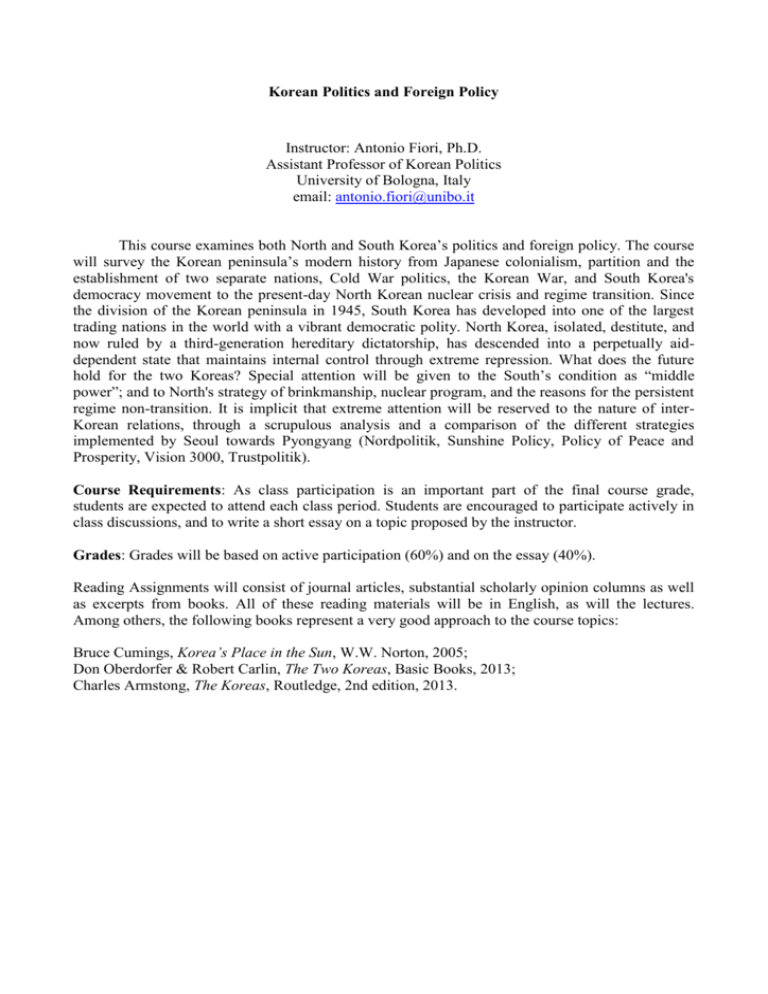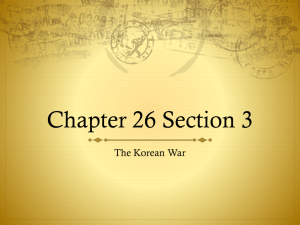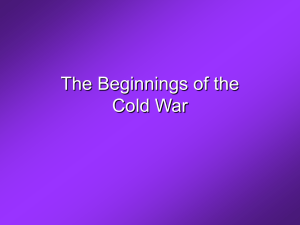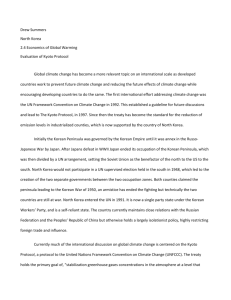Korean Politics and Foreign Policy
advertisement

Korean Politics and Foreign Policy Instructor: Antonio Fiori, Ph.D. Assistant Professor of Korean Politics University of Bologna, Italy email: antonio.fiori@unibo.it This course examines both North and South Korea’s politics and foreign policy. The course will survey the Korean peninsula’s modern history from Japanese colonialism, partition and the establishment of two separate nations, Cold War politics, the Korean War, and South Korea's democracy movement to the present-day North Korean nuclear crisis and regime transition. Since the division of the Korean peninsula in 1945, South Korea has developed into one of the largest trading nations in the world with a vibrant democratic polity. North Korea, isolated, destitute, and now ruled by a third-generation hereditary dictatorship, has descended into a perpetually aiddependent state that maintains internal control through extreme repression. What does the future hold for the two Koreas? Special attention will be given to the South’s condition as “middle power”; and to North's strategy of brinkmanship, nuclear program, and the reasons for the persistent regime non-transition. It is implicit that extreme attention will be reserved to the nature of interKorean relations, through a scrupulous analysis and a comparison of the different strategies implemented by Seoul towards Pyongyang (Nordpolitik, Sunshine Policy, Policy of Peace and Prosperity, Vision 3000, Trustpolitik). Course Requirements: As class participation is an important part of the final course grade, students are expected to attend each class period. Students are encouraged to participate actively in class discussions, and to write a short essay on a topic proposed by the instructor. Grades: Grades will be based on active participation (60%) and on the essay (40%). Reading Assignments will consist of journal articles, substantial scholarly opinion columns as well as excerpts from books. All of these reading materials will be in English, as will the lectures. Among others, the following books represent a very good approach to the course topics: Bruce Cumings, Korea’s Place in the Sun, W.W. Norton, 2005; Don Oberdorfer & Robert Carlin, The Two Koreas, Basic Books, 2013; Charles Armstong, The Koreas, Routledge, 2nd edition, 2013. ESSENTIAL READINGS First week: Historical Development of Politics in the Korean Peninsula Jang-Jip Choi, “Political Cleavages in South Korea,” in State and Society in Contemporary Korea, edited by Hagen Koo, Ithaca: Cornell Un. Press, 1993, pp. 13-50; Soong Hoom Kil, “Development of Korean Politics. A Historical Profile,” in Understanding Korean Politics, edited by Soong Hoom Kil and Chung-in Moon, Albany: SUNY, pp. 2001. Second week: South Korean Political Processes (Regionalism; political parties; presidential elections; civil society & social movements; political protest; political culture) Paul Y. Chang and Gi-Wook Shin, “Democratization and the Evolution of Social Movements in Korea,” in South Korean Social Movements, edited by Gi-Wook Shin and Paul Y. Chang, London: Routledge, 2011, pp. 3-18; Sunhyuk Kim, “Civil Society and Democratization,” in Korean Society, edited by Charles Armstrong, London: Routledge, pp. 92-108; David Steinberg and Myung Shin, “Tension in South Korean Political Parties in Transition,” Asian Survey, vol. 46, no. 4, 2006, pp. 517-37; Eui Hang Shin, “Presidential Elections, Internet Politics, and Citizens’ Organizations in South Korea,” Development and Society, vol. 34, no. 1, 2005, pp. 25-47. Third week: South Korea’s Political and Economic Journey From Aid Recipient to Donor: Being a Middle Power in Concrete (South Korea’s Foreign Policy; South Korea as a Middle Power; Relations with the United States, China, Japan, and Europe). David Shim and Patrick Flamm, “Rising South Korea: A Minor Player or a Regional Power?,” Pacific Focus, vol. 28, no. 3, 2013; Thomas Kalinowski and Hyekyung Cho, “Korea’s Search for a Global Role Between Hard Economic Interests and Soft Power,” European Journal of Development Research, vol. 24, no. 2, 2012, pp. 242-260; Weston S. Konishi and Mark E. Manyin, “South Korea: Its Domestic Politics and Foreign Policy Outlook,” Congressional Research Service, September 30, 2009. Fourth week: “Knowing the Kims”: North Korea’s Domestic and Foreign Policy Jae-Cheon Lim, “North Korea’s Hereditary Succession: Comparing Two Key Transitions in the DPRK,” Asian Survey, vol. 52, no. 3, pp. 550-570; International Crisis Group, “North Korean Succession and the Risks of Instability,” Crisis Group Asia Report N°230, 25 July 2012; Mun Suk Ahn, “Kim Jong-il’s Death and His Son’s Strategy for Seizing Power in North Korea,” Problems of Post-Communism, vol. 59, no. 4, July-August 2012, pp. 27-37. Fourth week: The Nature of Inter-Korean Relations David Kang, “The North Korean Issue, Park Geun-hye’s Presidency, and the Possibility of Trust-Building on the Korean Peninsula,” International Journal of Korean Unification Studies, vol. 22, no. 1, 2013, pp. 1-21; Chung-in Moon, “The Sunshine Policy and the Korean Summit,” East Asian Review, vol. 12, no. 4, 2000, pp. 3-36. Fifth week: The Future of the Korean Peninsula Bonnie S. Glaser and Britanny Billingsley, “Reordering Chinese Priorities on the Korean Peninsula,” Center for Strategic and International Studies, November 2012.








